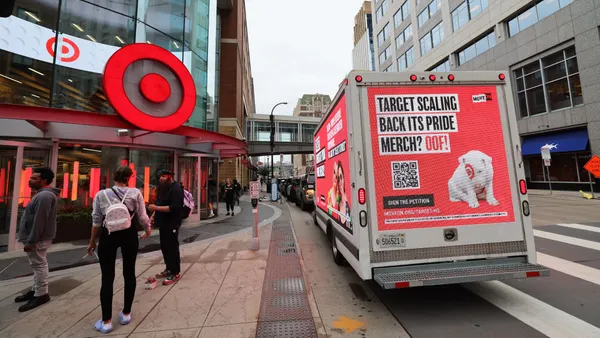Dive Brief:
- WPP's media agency GroupM this week revised its estimates for U.S. advertising expenditures, predicting that digital ads will make up more than half of total spending for the first time. Digital ad spending will grow 5.4% to $110.1 billion this year, or 51% of the total $214.6 billion excluding political ads. Digital next year will see an 18% jump to $130 billion, or 54% of the total $240 billion, as demand recovers, per GroupM's forecast.
- The agency offered a somewhat better outlook than it did six months ago after marketers canceled or delayed campaigns because of the pandemic. The $214.6 billion figure for U.S. spending excluding political ads represents an 8.8% decline, a revision from its June forecast for a 13% drop. The growth rate will rebound to 12% next year, before settling to 4.8% in 2022, GroupM predicted.
- Google, Facebook and Amazon will be the biggest beneficiaries of digital ad growth, having a combined market share of about two-thirds of the U.S. digital ad market, the Wall Street Journal reported, citing data from eMarketer. The companies have "done a good job of showing ad performance," Christian Juhl, GroupM’s global chief executive, told the newspaper.
Dive Insight:
The predicted growth in digital advertising, which contrasts with the contraction seen in other media channels, indicates that marketers see the value of online media in reaching target audiences and supporting their e-commerce efforts, according to GroupM. Digital advertising is accessible to a broad range of marketers, including small businesses that have been forced to grow their online presence as many consumers avoid shopping in stores during the pandemic.
"While liquidity risks, reduced spending and physical store closures were widespread, these headwinds were sufficiently offset by an accelerated focus on e-commerce initiatives," according to GroupM. "This likely led to a rapid expansion in support for digital advertising."
GroupM's analysis is bolstered by the recent earnings results from Amazon, Facebook and Google's parent company Alphabet. Amazon's advertising revenue jumped 51% to $5.4 billion in Q3 from a year earlier as marketers sought to reach the e-commerce giant's customers while they shopped online. Because Amazon's advertising business is less mature than Facebook and Google's, the growth rate has been higher in the past few years. Facebook's ad revenue increased 22% to $21.2 billion in Q3, despite an advertiser boycott because of the social network's policies on removing hate speech. Google's ad revenue rose 9.8% to $37.1 billion, driven by a 32% gain to $5 billion for video-sharing site YouTube. The dominance of the three companies in their respective markets has invited scrutiny from antitrust authorities worldwide.
The predicted growth in digital advertising contrasts with the contraction in traditional media observed by GroupM. Excluding political ads, spending on national TV advertising will decline 7.9% to $39.5 billion this year, and bounce back with 6.6% growth to $42.1 billion in 2021, the agency predicted. National TV is performing better than any other media channel aside from digital, as major advertisers have adapted their sales and marketing strategies to shifts in consumer behavior. Local TV advertising will see a 22% drop to $16.5 billion this year, followed by a 2.7% gain to $16.9 billion in 2021, according to GroupM.
Among other media categories, out-of-home (OOH) advertising will drop 31% to $5.9 billion this year, and rebound by 23% to $7.2 billion next year. The recovery likely will happen in the second half of next year on a return to normalcy, according to GroupM. Its prediction reflects broader optimism that the distribution of successful coronavirus vaccines will help to bring an end to the pandemic, letting people return to their former routines of commuting to work and seeing OOH ads.
Audio advertising including digital will fall by 27% to $12 billion this year, and grow 6.6% to $12.8 billion in 2021, reflecting a weak local market. Direct mail will generate $11.6 billion this year for a 26% decline from 2019, and bounce back by 17% to $13.6 billion next year. Magazines will see a 20% drop to $8.7 billion this year, followed by an 8.3% decline to $7.9 billion in 2021. Newspapers will experience a 30% decrease to $8.8 billion this year, and 12% decline to $7.7 billion next year, GroupM predicted.










